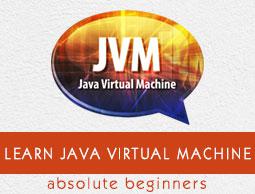Java Virtual Machine - Runtime Data Areas
The JVM spec defines certain run-time data areas that are needed during the execution of the program. Some of them are created while the JVM starts up. Others are local to threads and are created only when a thread is created (and destroyed when the thread is
destroyed). These are listed below −
PC (Program Counter) Register
It is local to each thread and contains the address of the JVM instruction that the thread
is currently executing.
Stack
It is local to each thread and stores parameters, local variables and return addresses during method calls. A StackOverflow error can occur if a thread demands more stack space than is permitted. If the stack is dynamically expandable, it can still throw
OutOfMemoryError.
Heap
It is shared among all the threads and contains objects, classes’ metadata, arrays, etc., that are created during run-time. It is created when the JVM starts and is destroyed when the JVM shuts down. You can control the amount of heap your JVM demands from the OS using certain flags (more on this later). Care has to be taken not to demand too less or too much of the memory, as it has important performance implications. Further, the GC manages this space and continually removes dead objects to free up the space.
Method Area
This run-time area is common to all threads and is created when the JVM starts up. It stores per-class structures such as the constant pool (more on this later), the code for constructors and methods, method data, etc. The JLS does not specify if this area needs
to be garbage collected, and hence, implementations of the JVM may choose to ignore GC. Further, this may or may not expand as per the application’s needs. The JLS does not mandate anything with regard to this.
Run-Time Constant Pool
The JVM maintains a per-class/per-type data structure that acts as the symbol table (one
of its many roles) while linking the loaded classes.
Native Method Stacks
When a thread invokes a native method, it enters a new world in which the structures and security restrictions of the Java virtual machine no longer hamper its freedom. A native method can likely access the runtime data areas of the virtual machine (it depends upon the native method interface), but can also do anything else it wants.
Garbage Collection
The JVM manages the entire lifecycle of objects in Java. Once an object is created, the developer need not worry about it anymore. In case the object becomes dead (that is, there is no reference to it anymore), it is ejected from the heap by the GC using one of the many algorithms – serial GC, CMS, G1, etc.
During the GC process, objects are moved in memory. Hence, those objects are not usable while the process is going on. The entire application has to be stopped for the duration of the process. Such pauses are called ‘stop-the-world’ pauses and are a huge overhead. GC
algorithms aim primarily to reduce this time. We shall discuss this in great detail in the following chapters.
Thanks to the GC, memory leaks are very rare in Java, but they can happen. We will see in the later chapters how to create a memory leak in Java.


